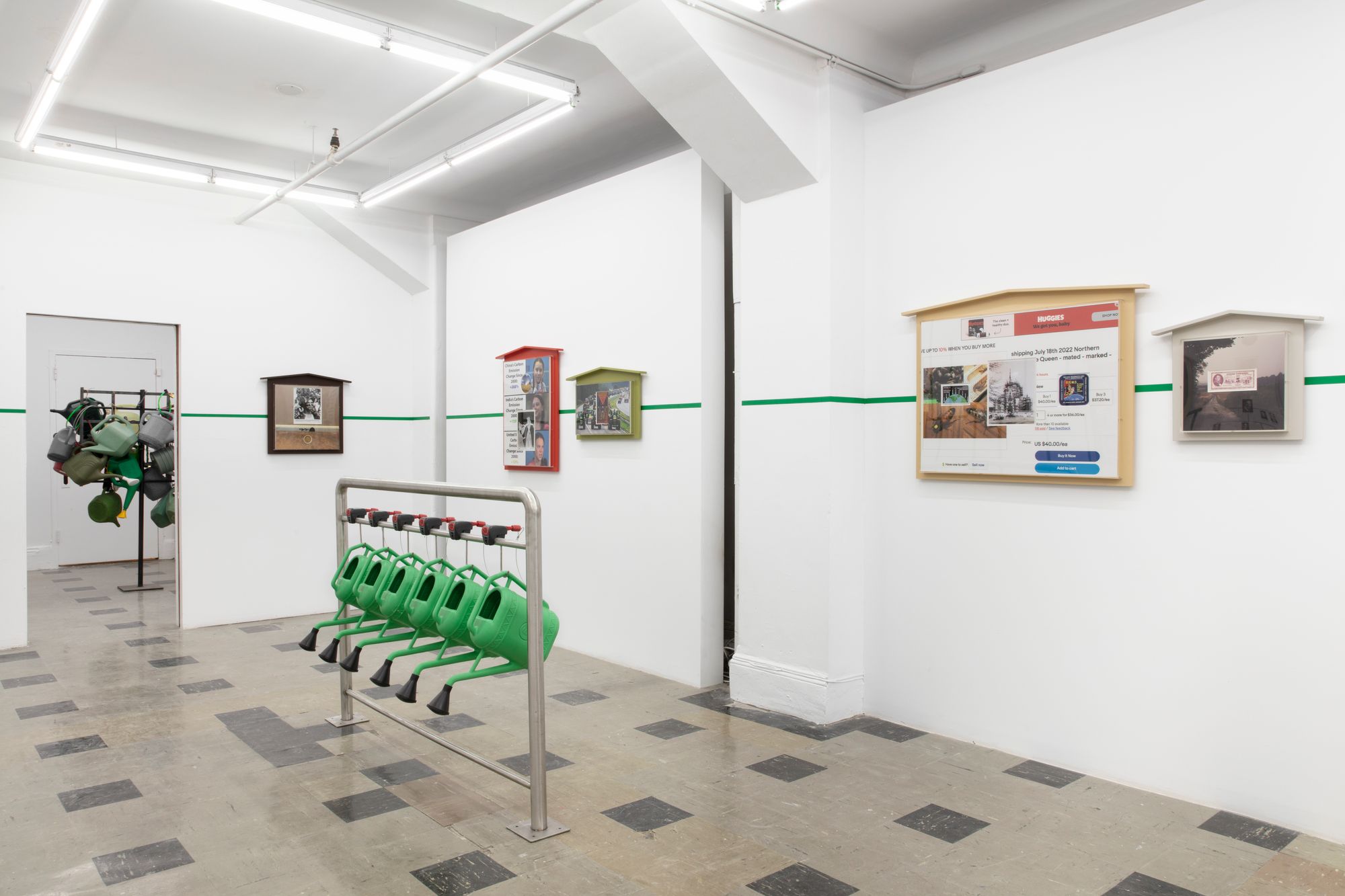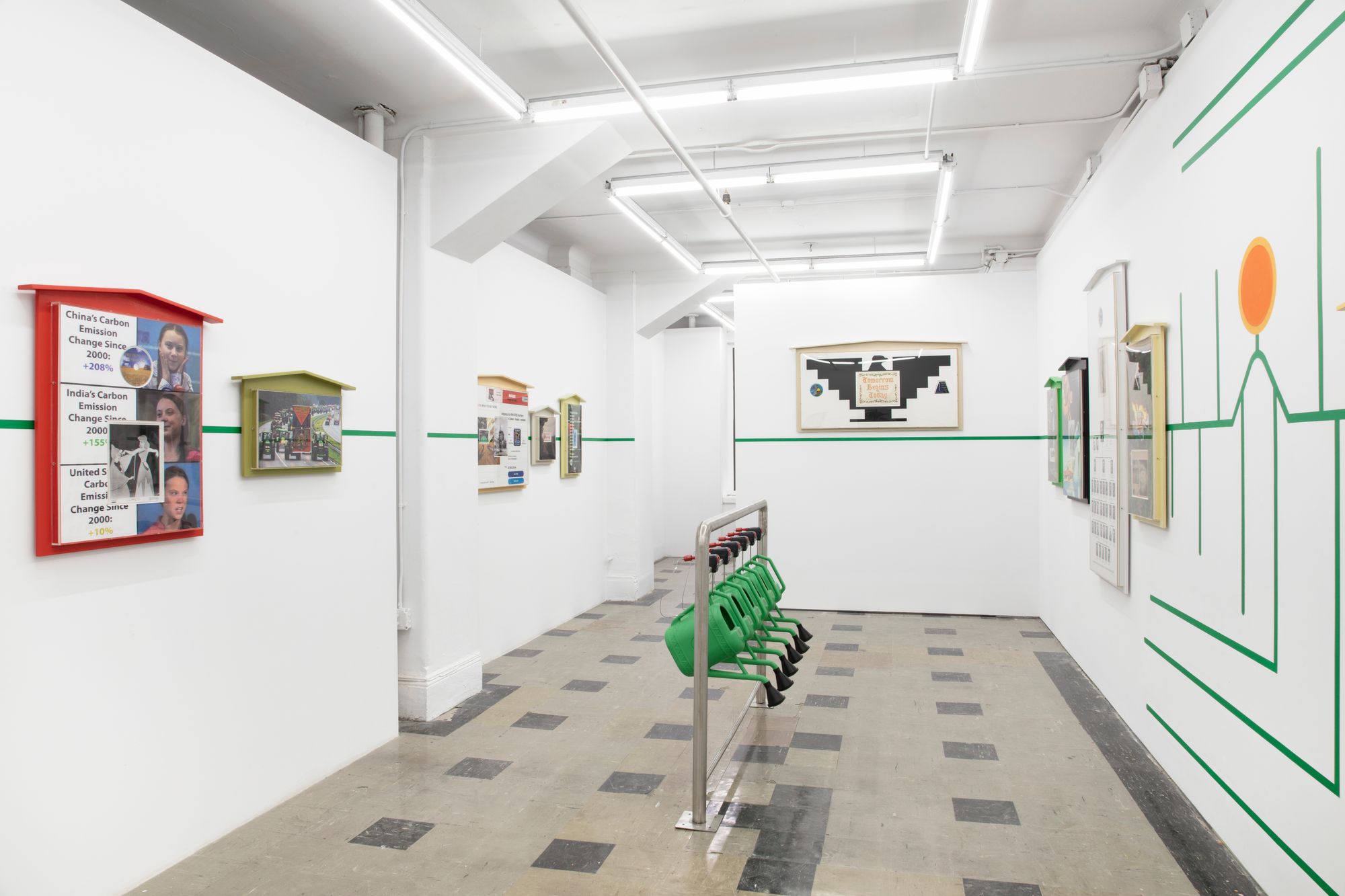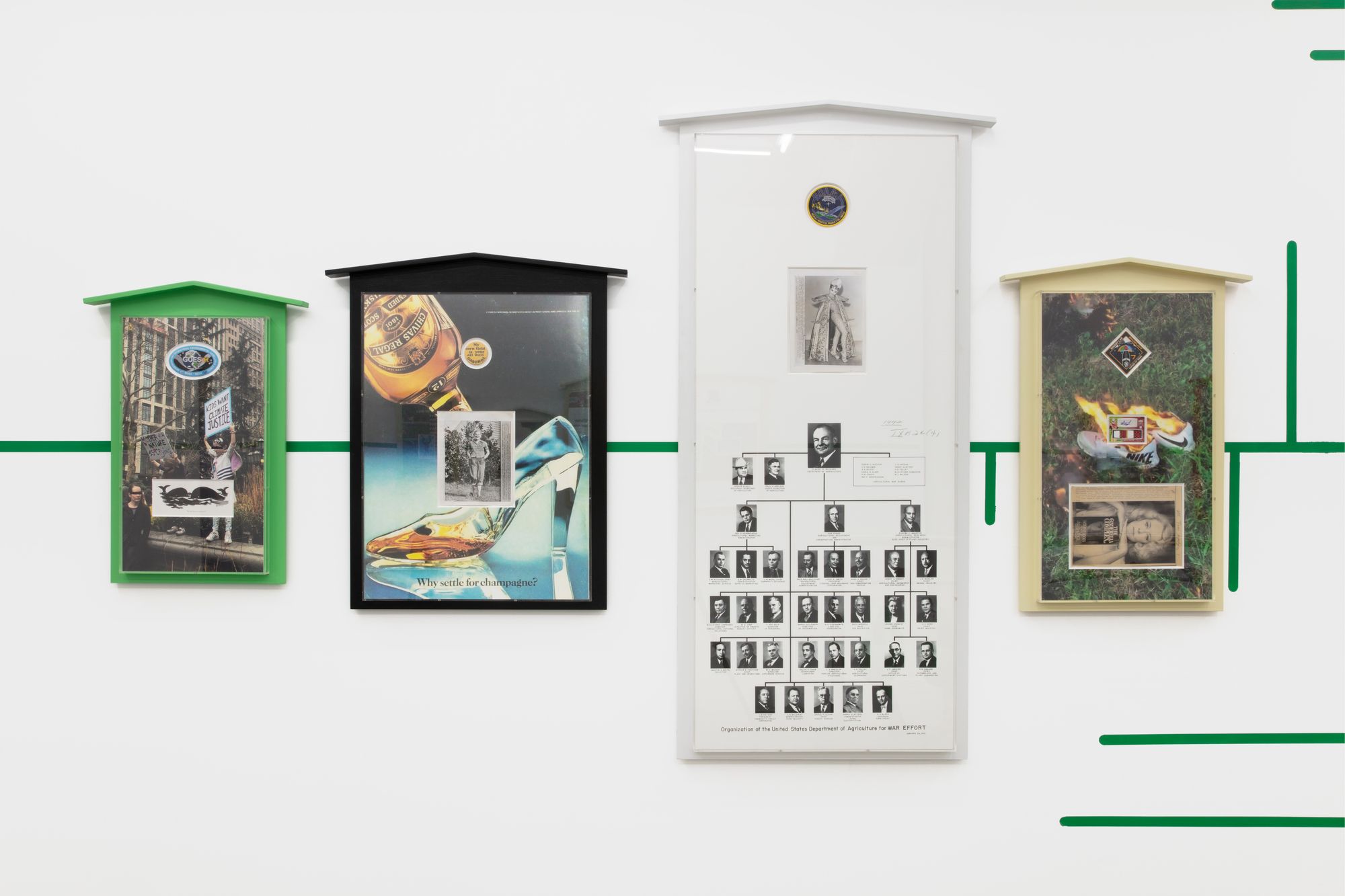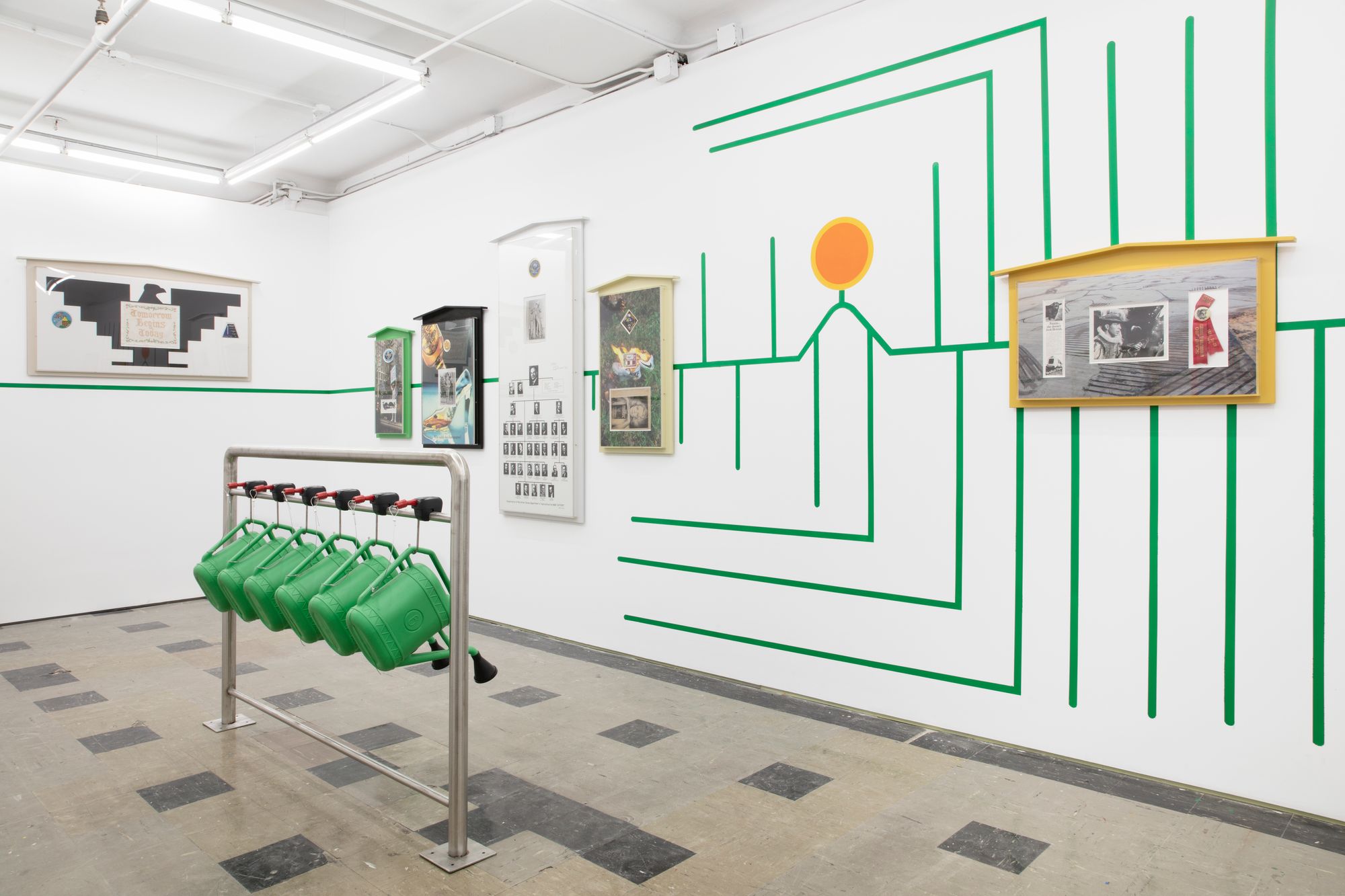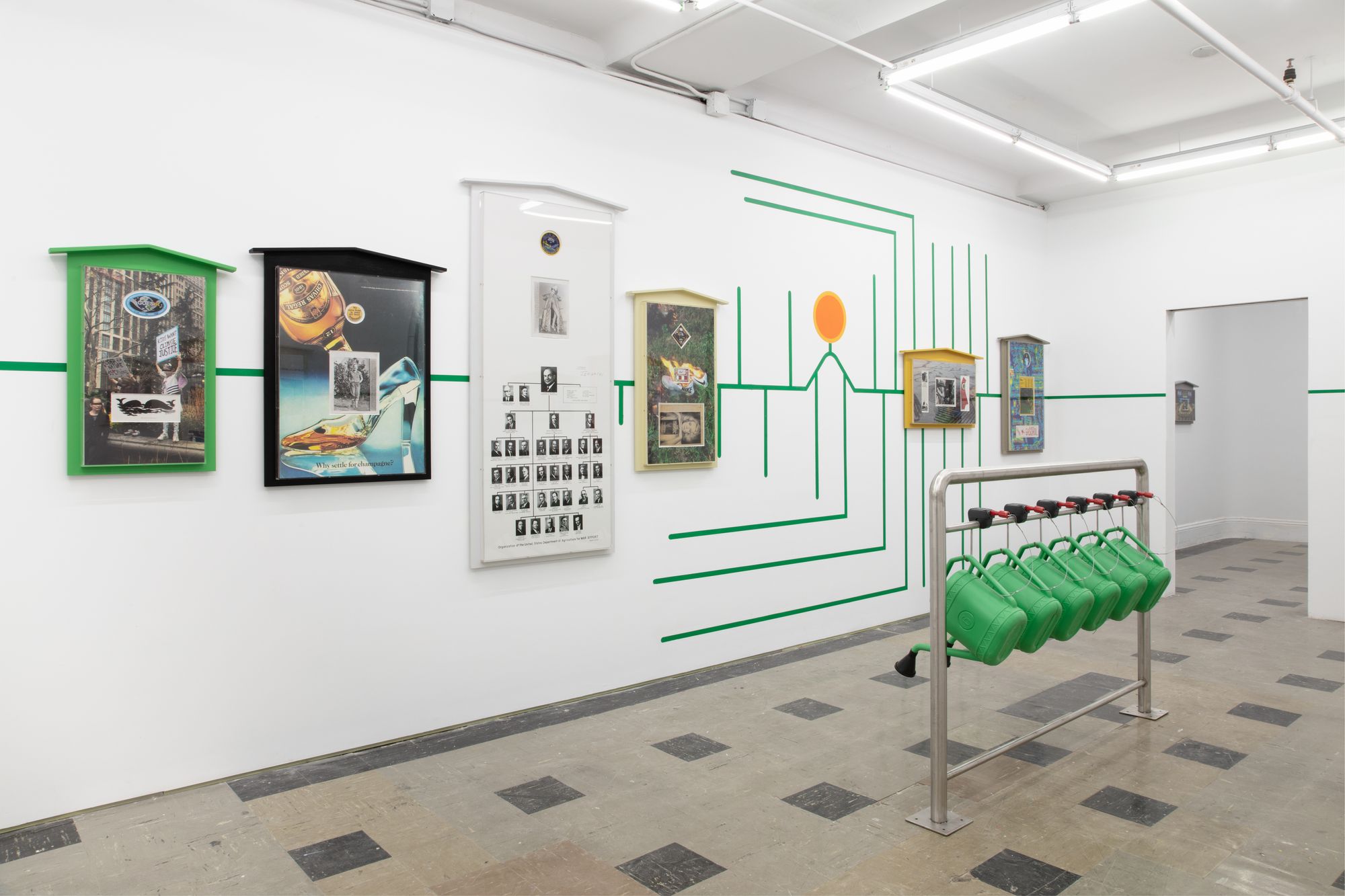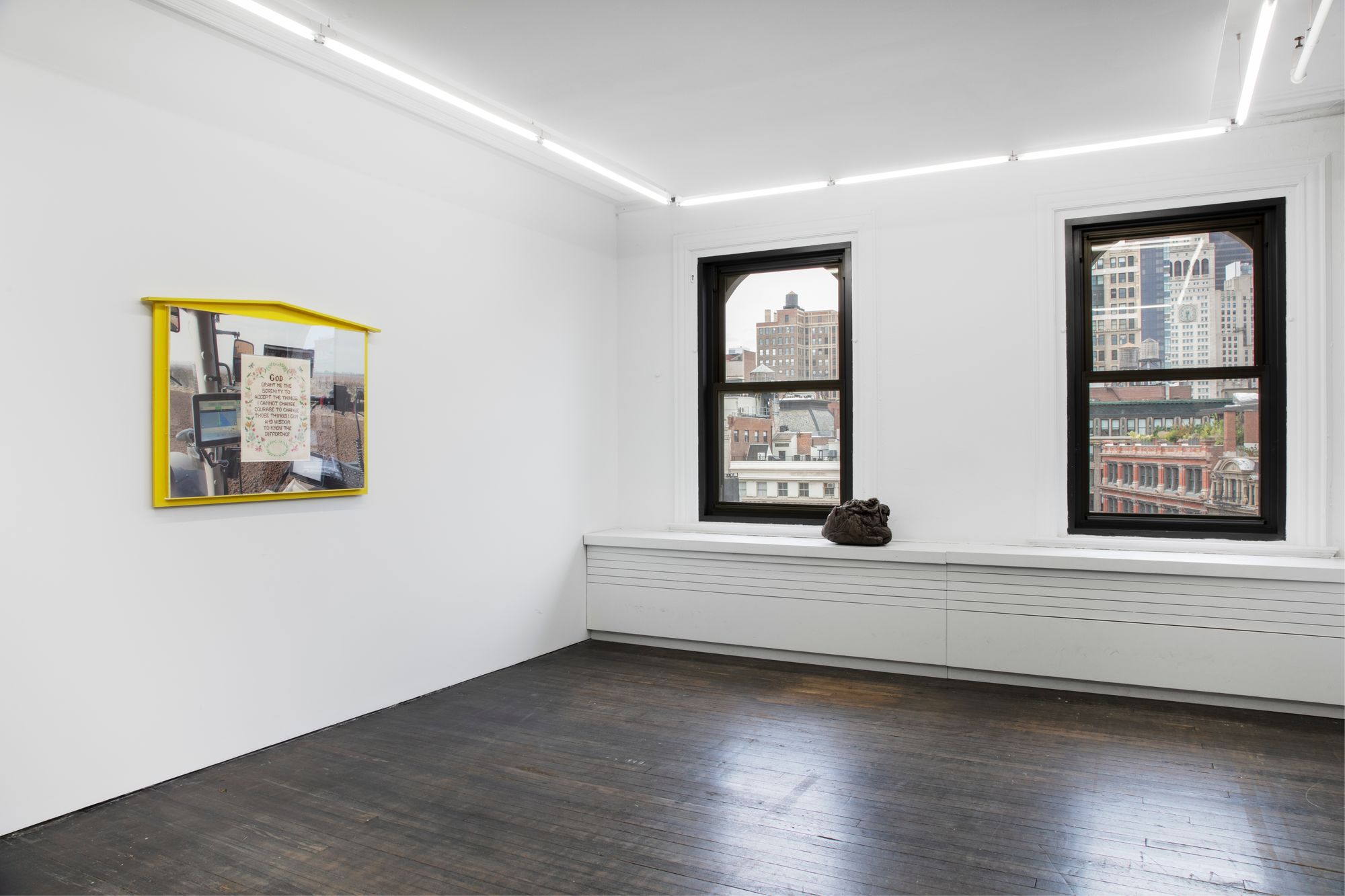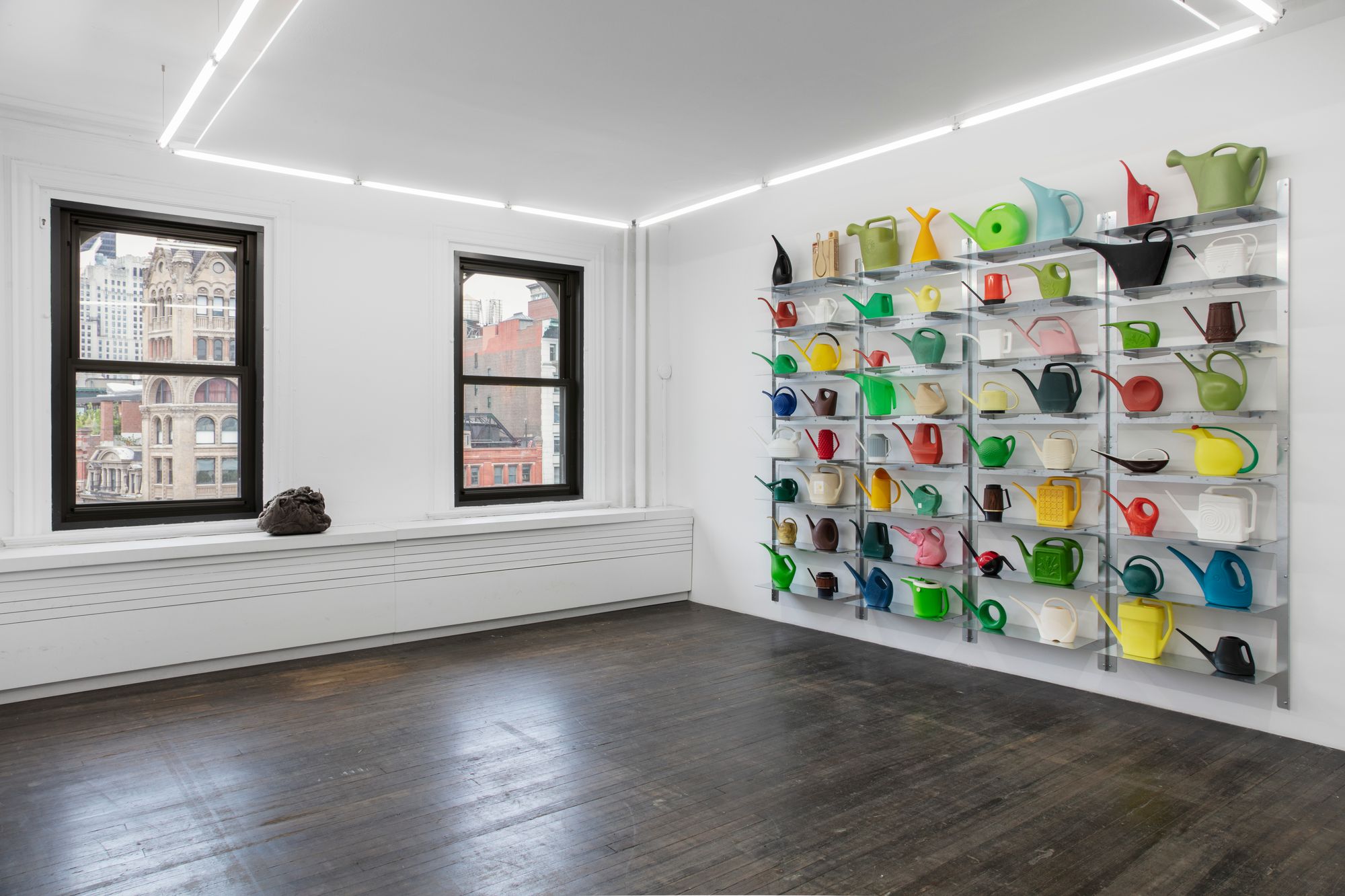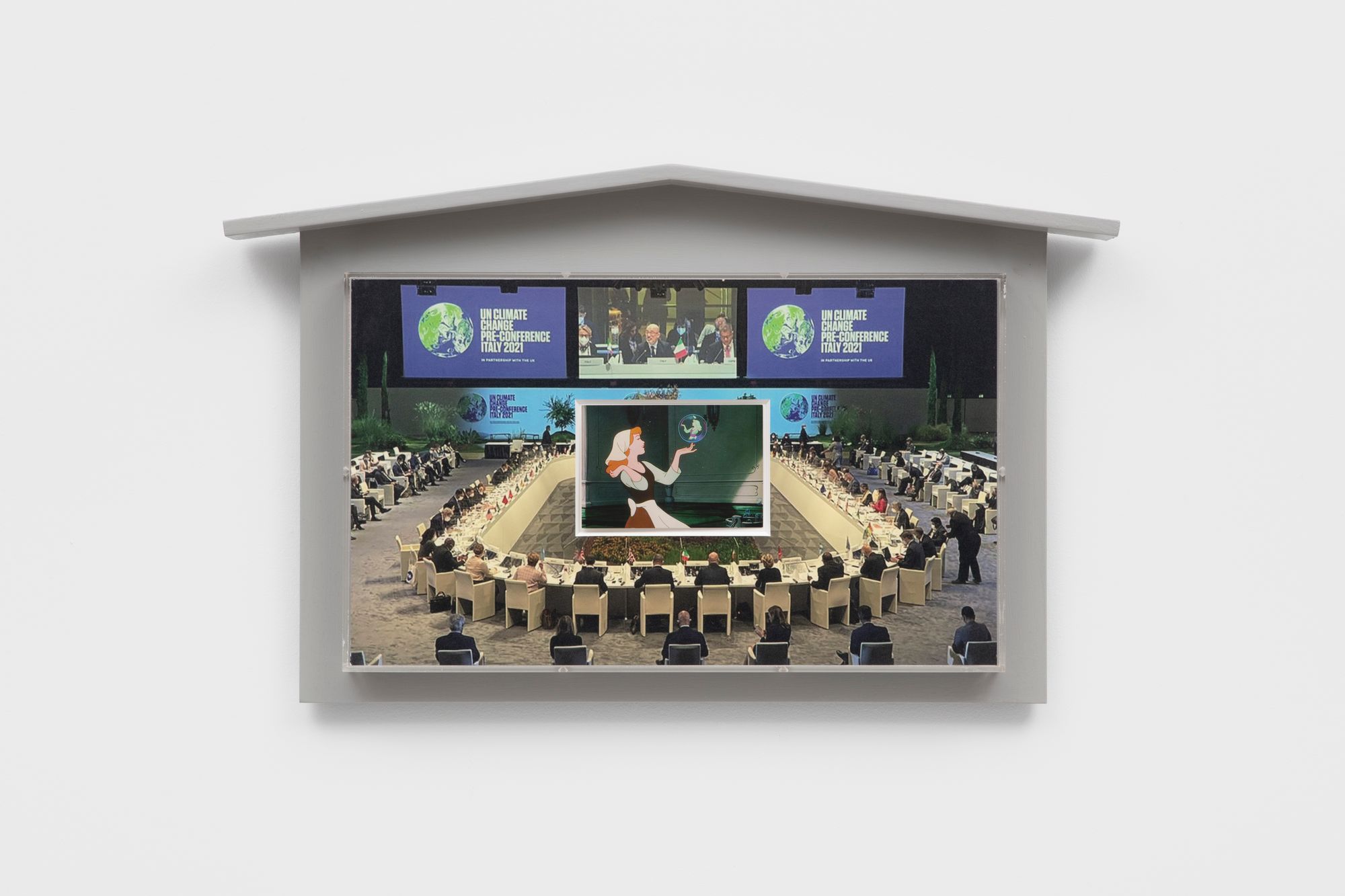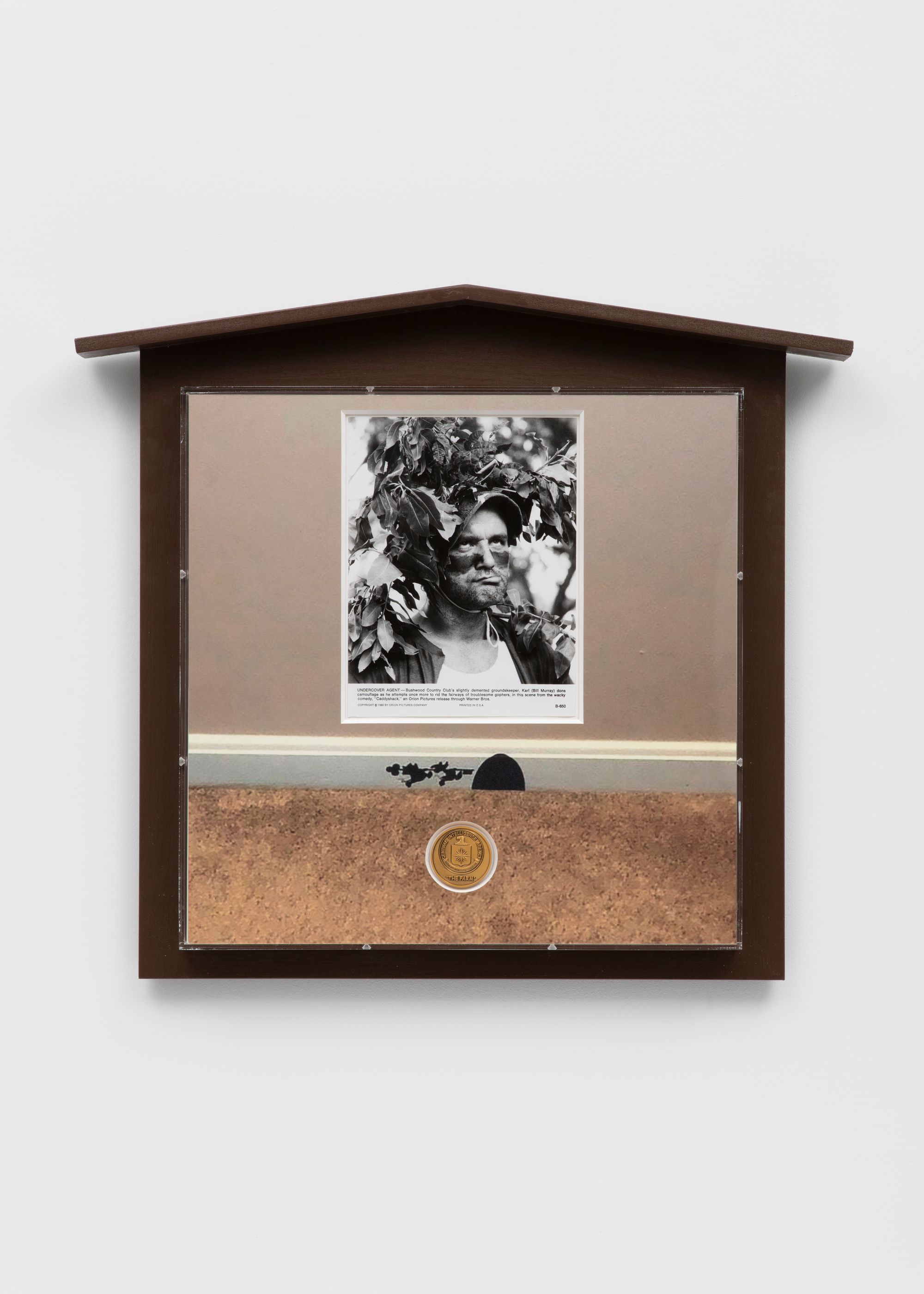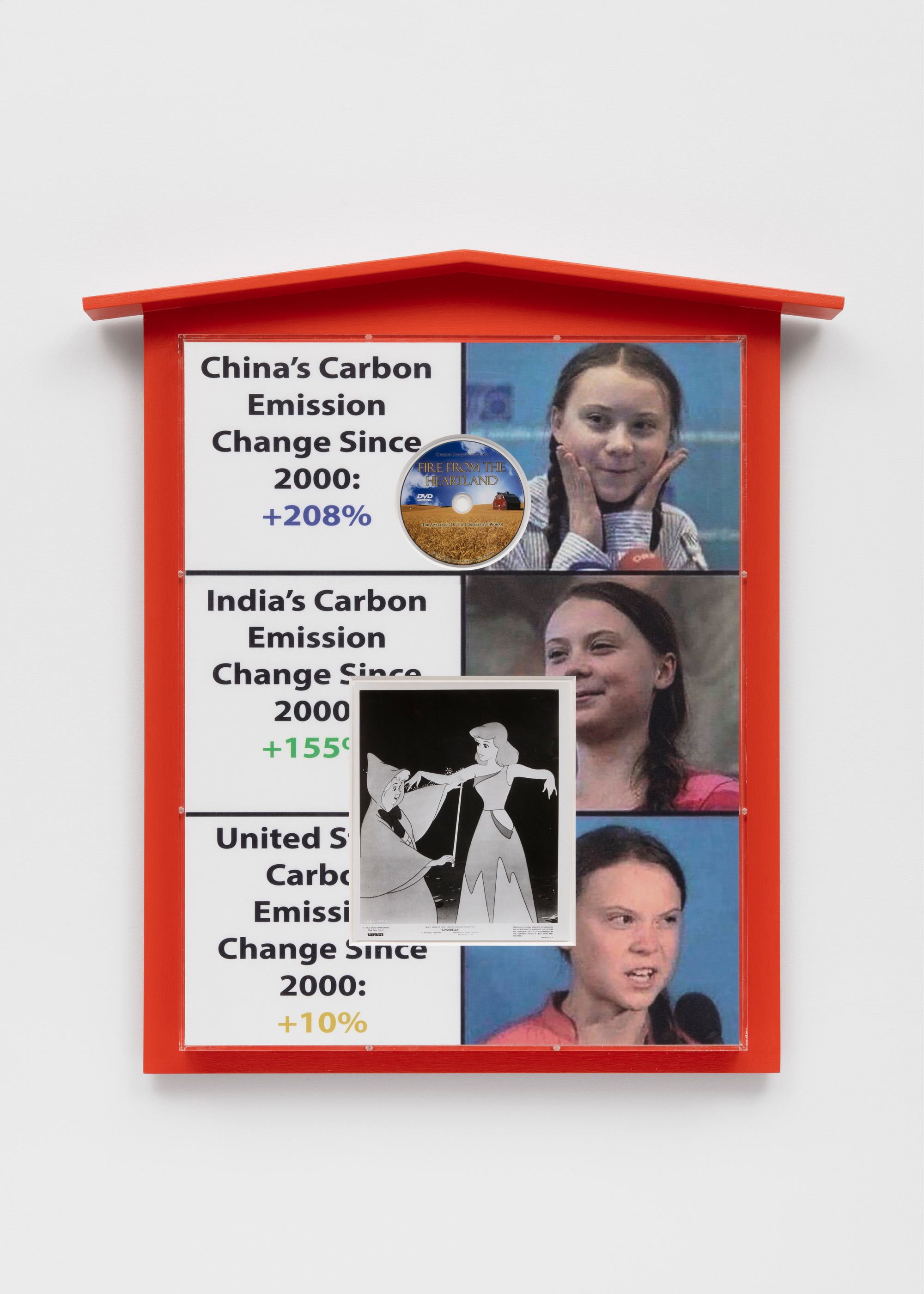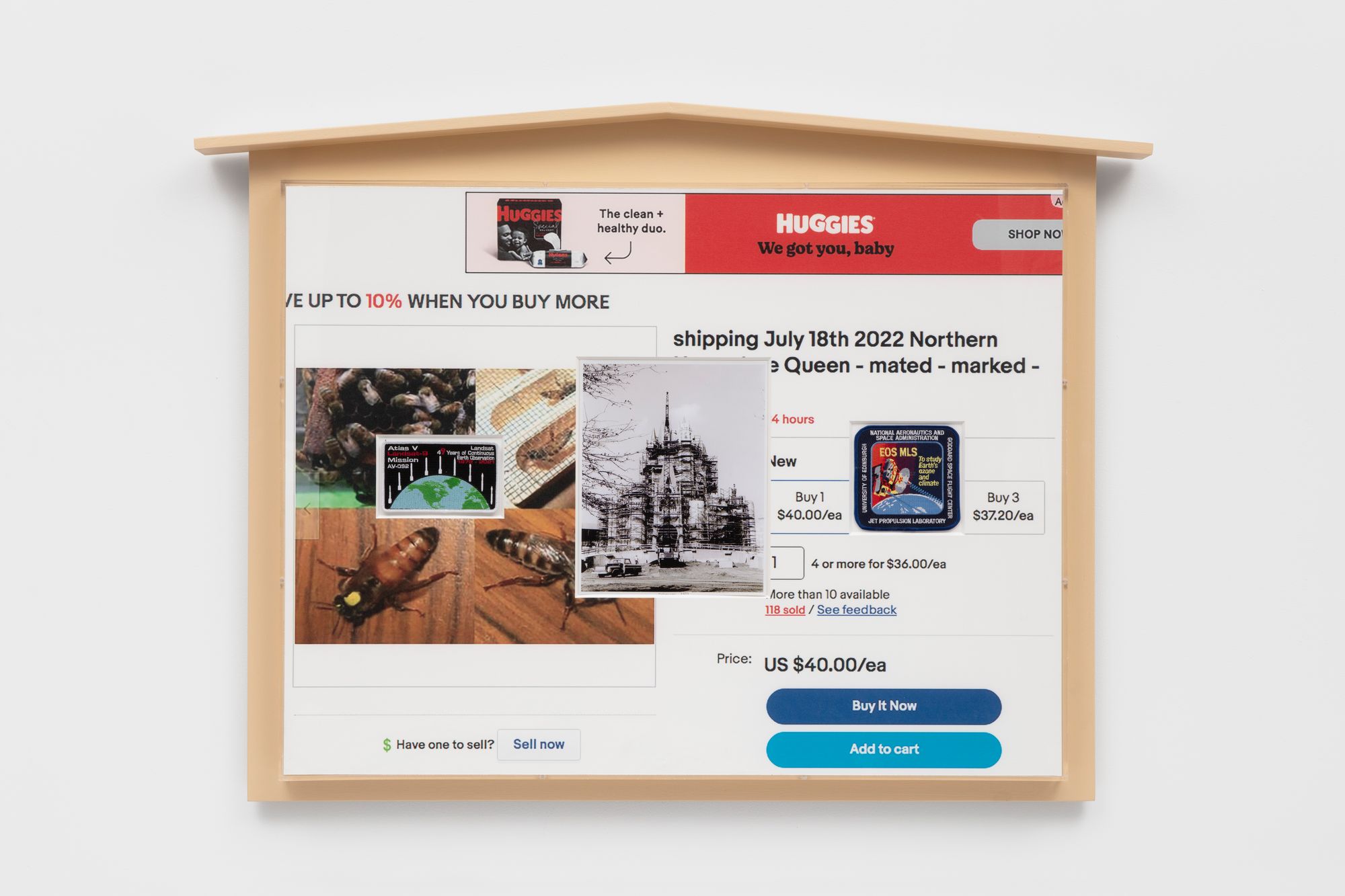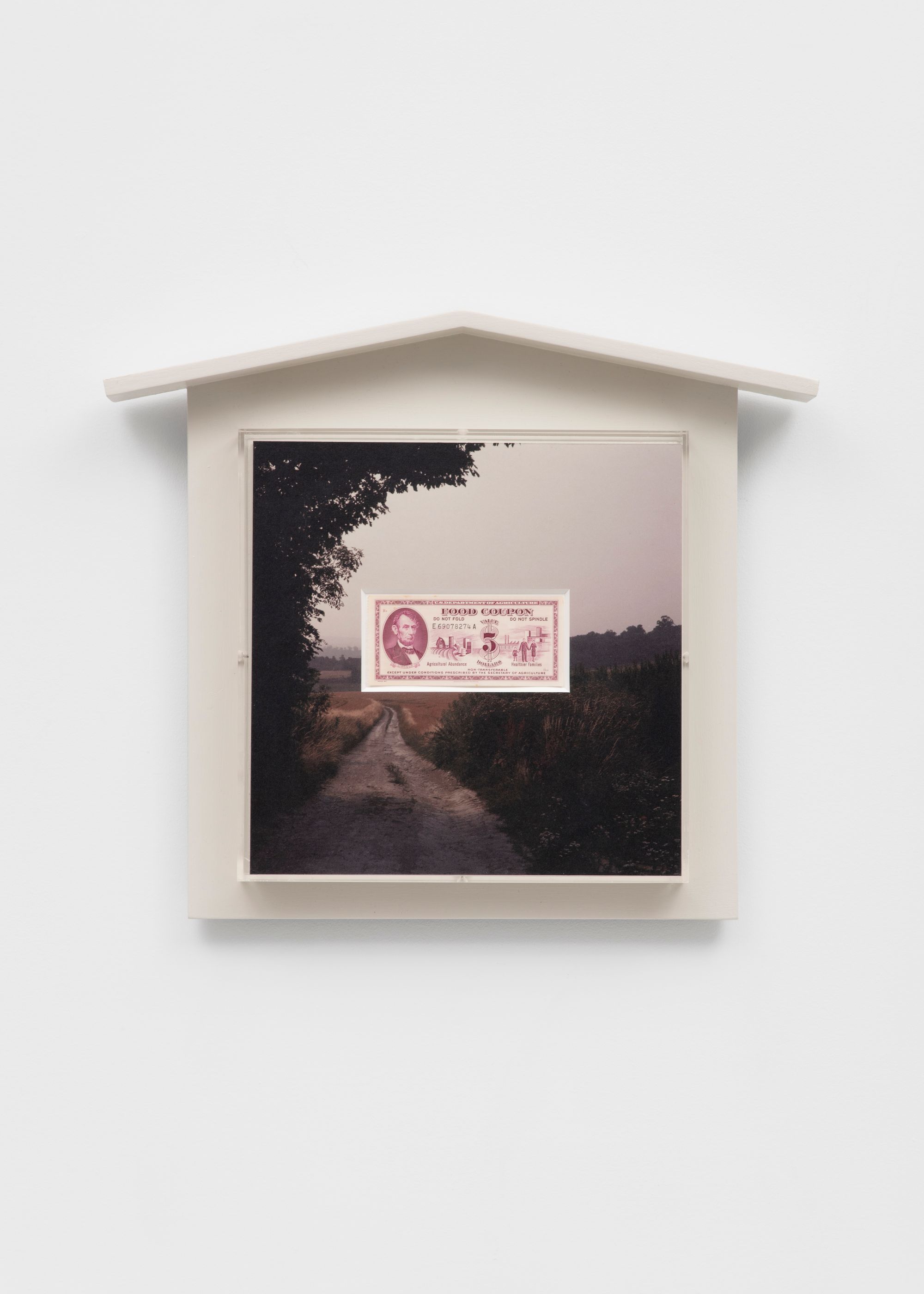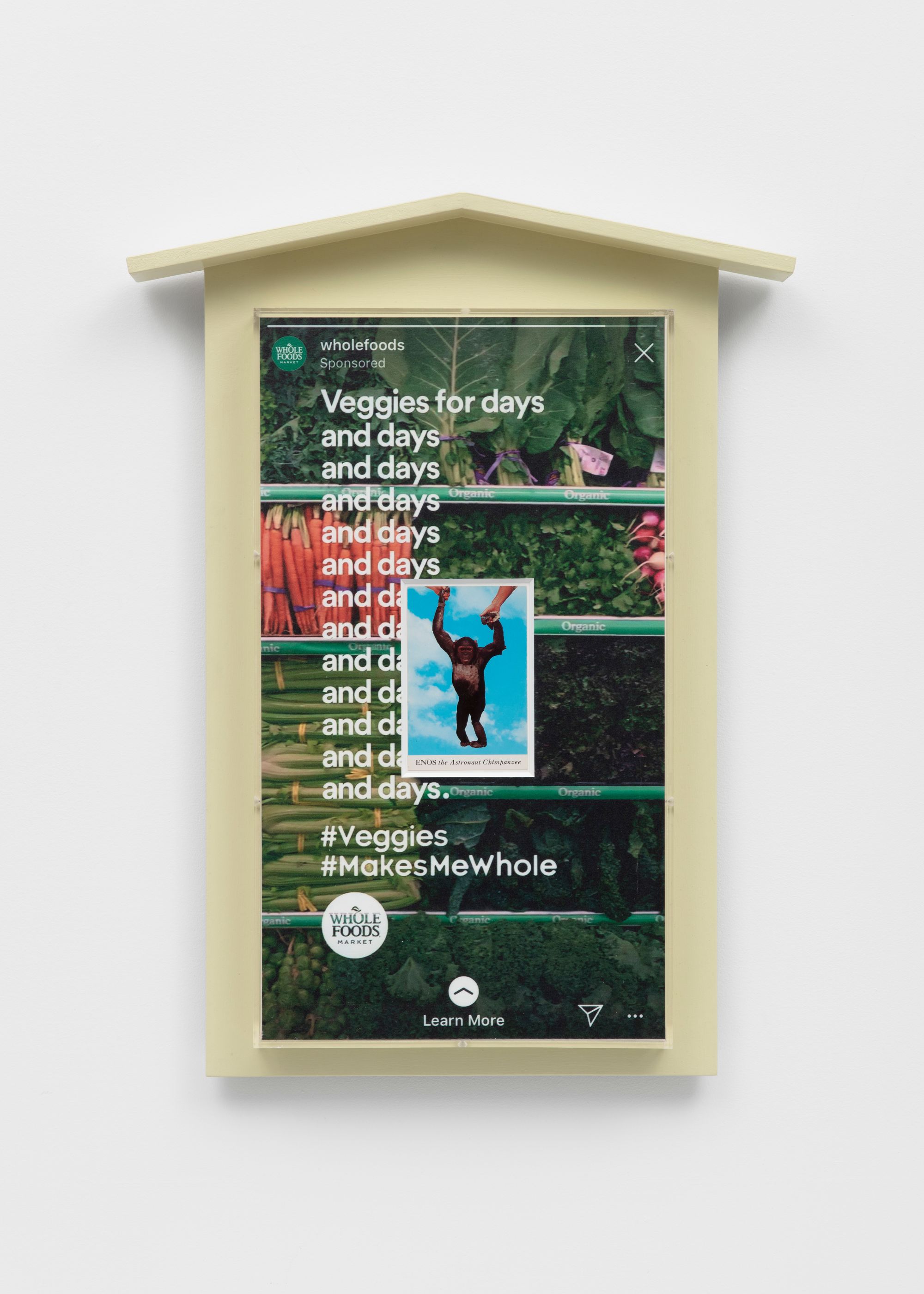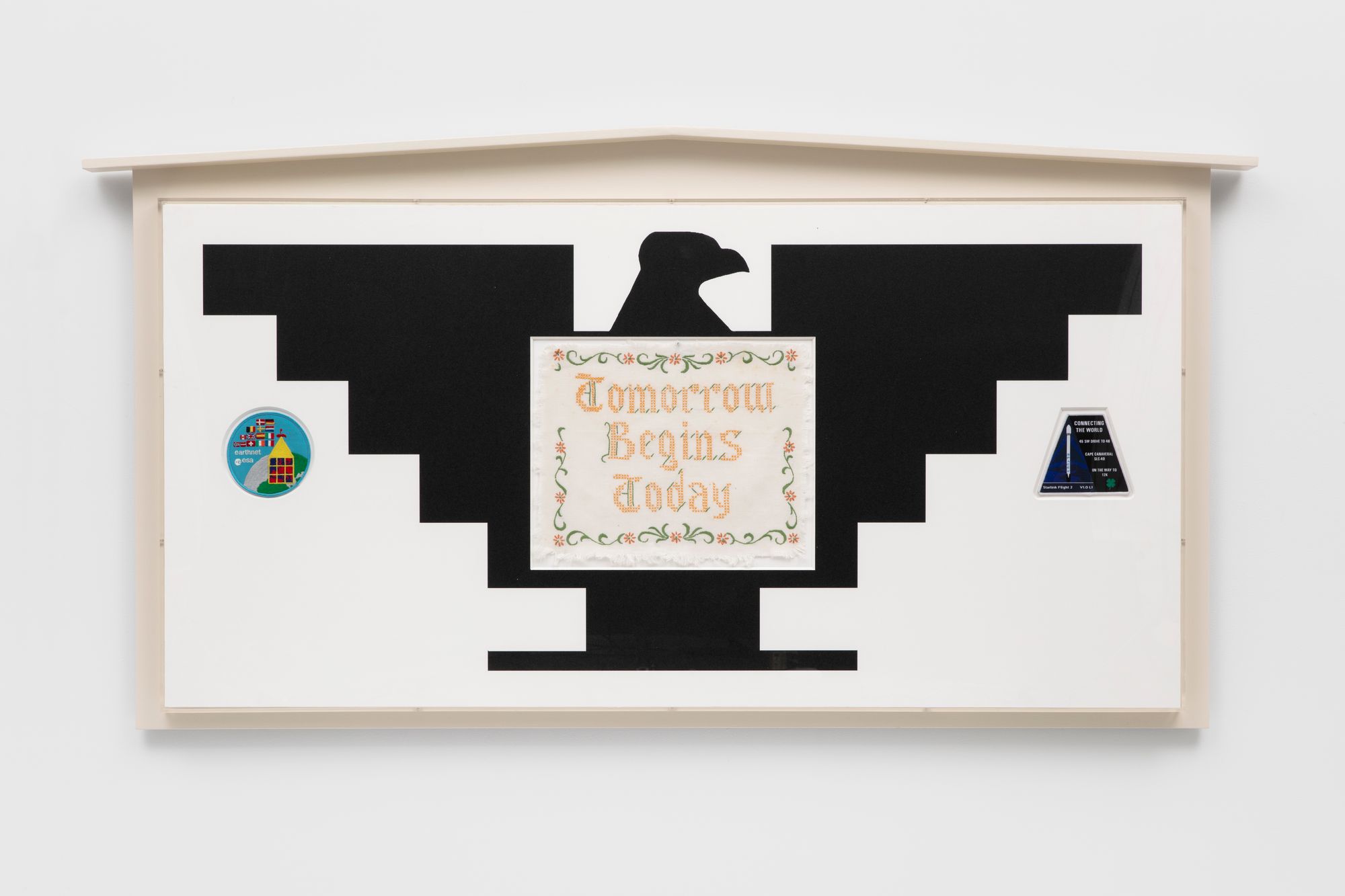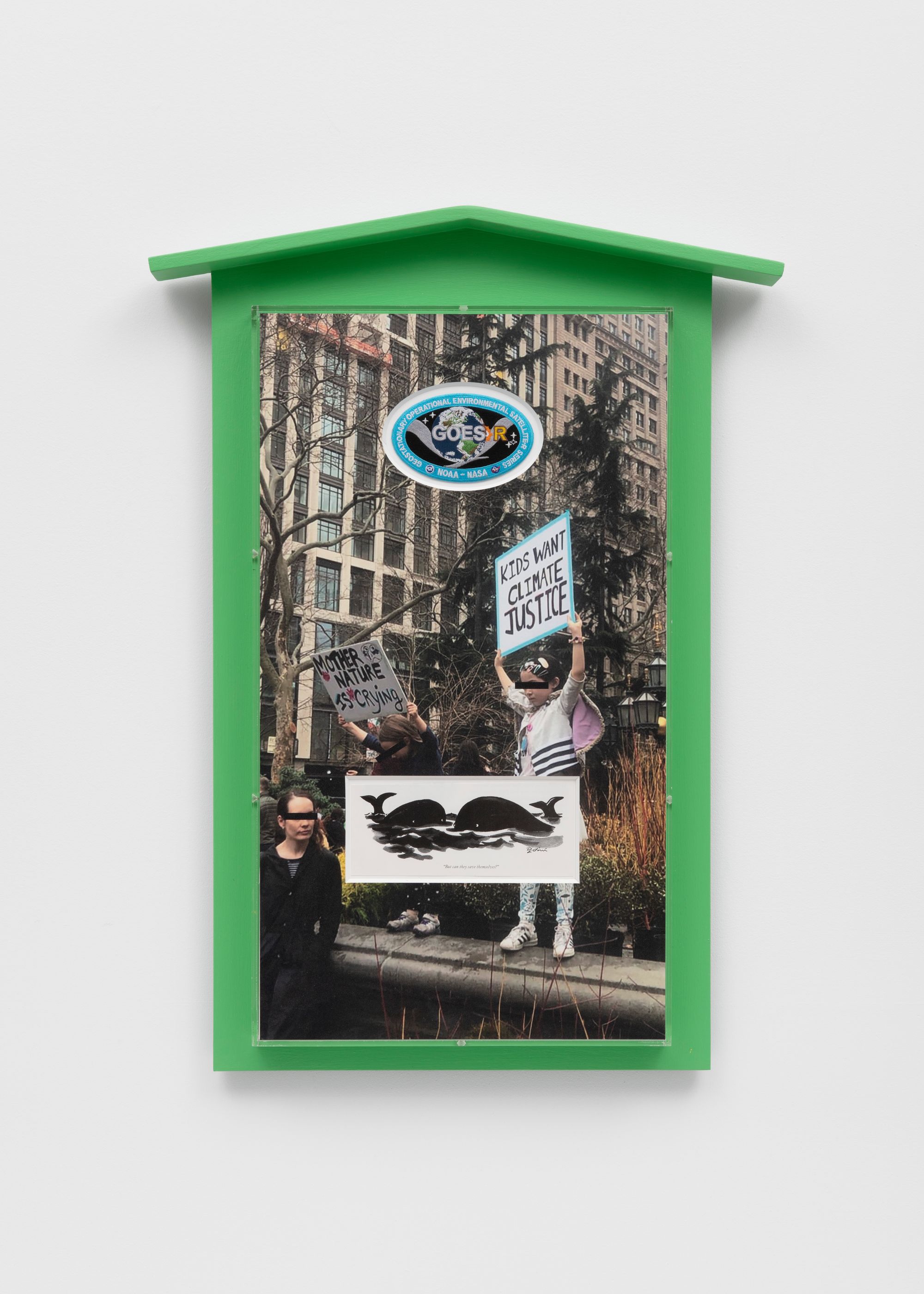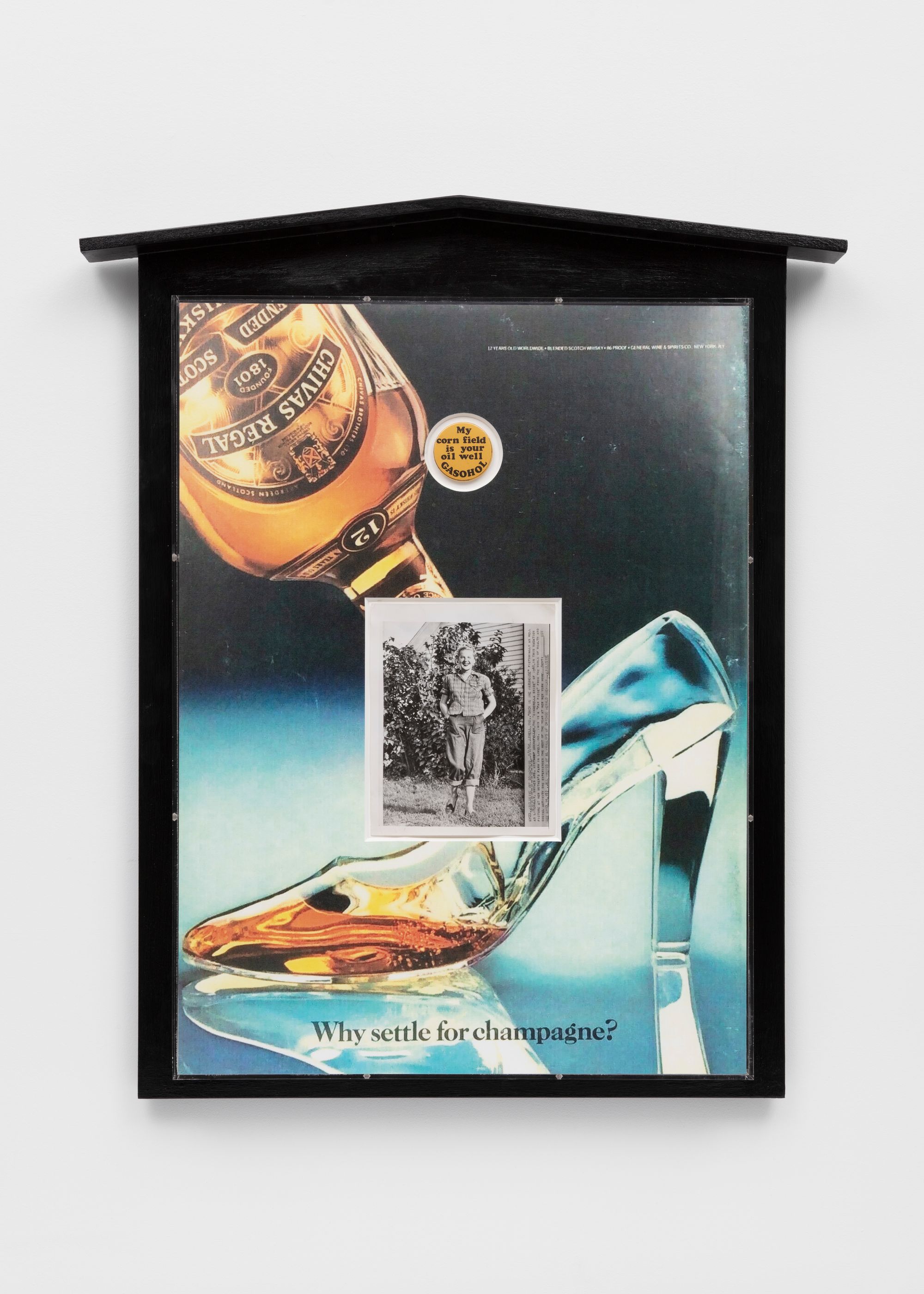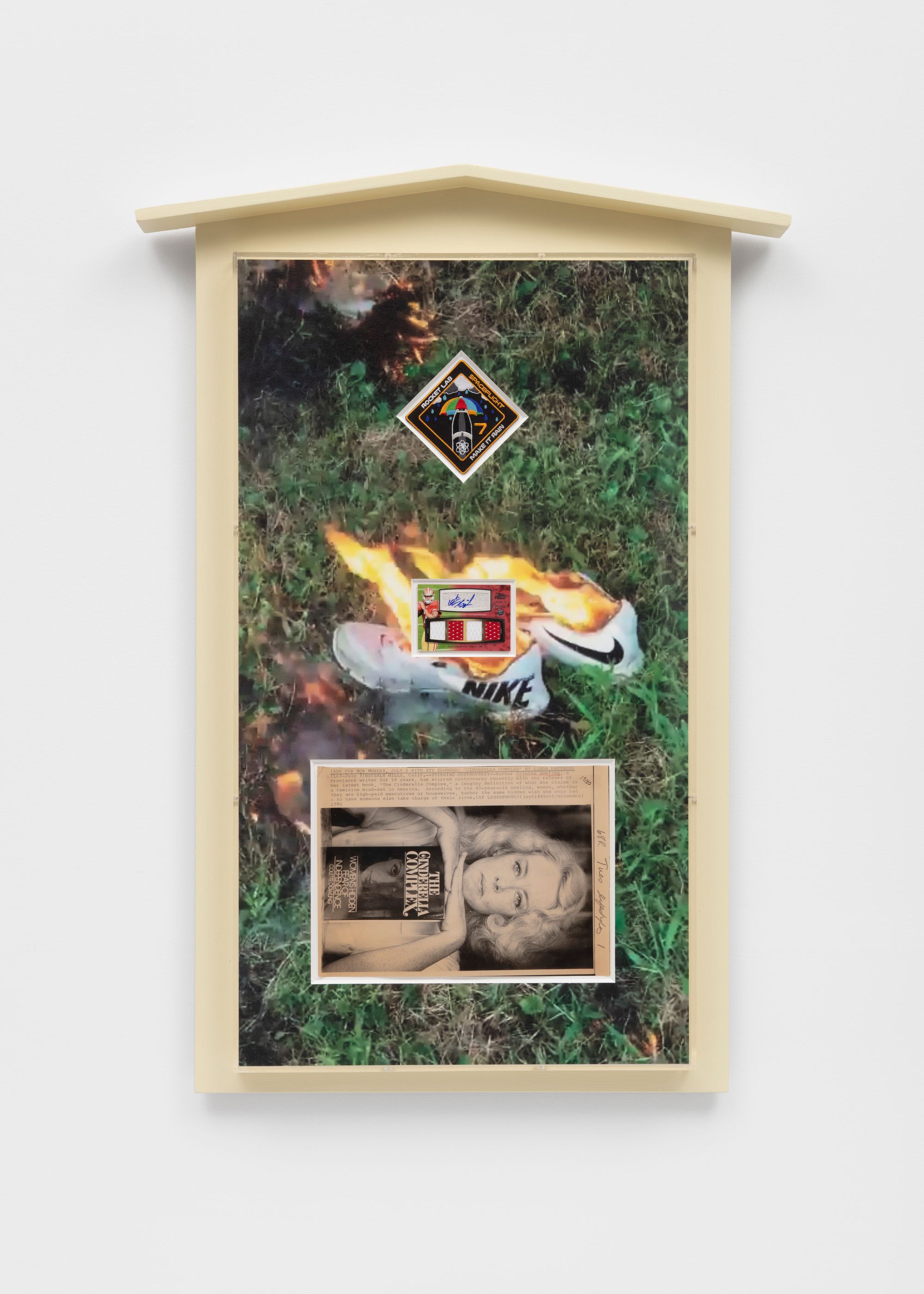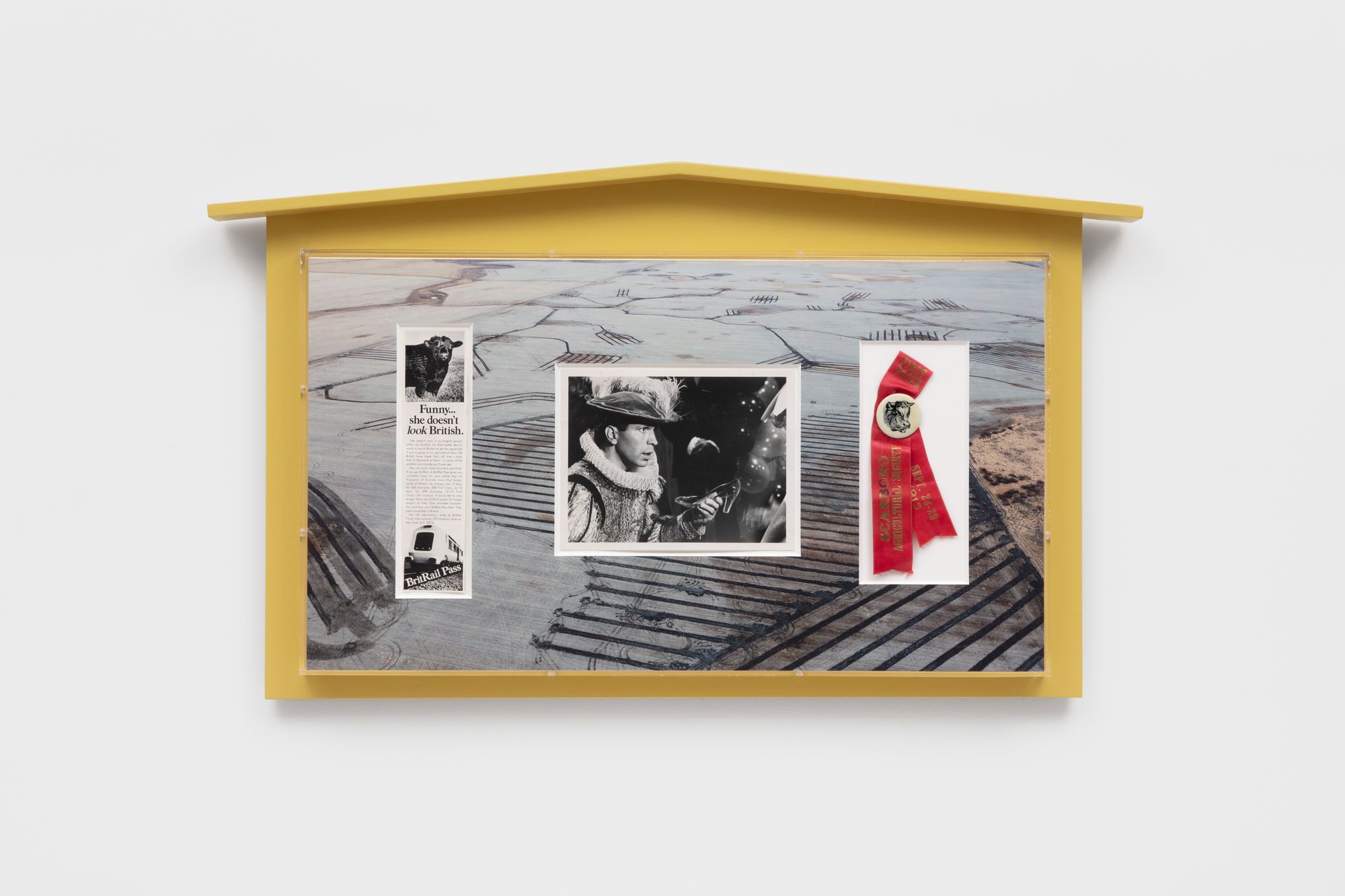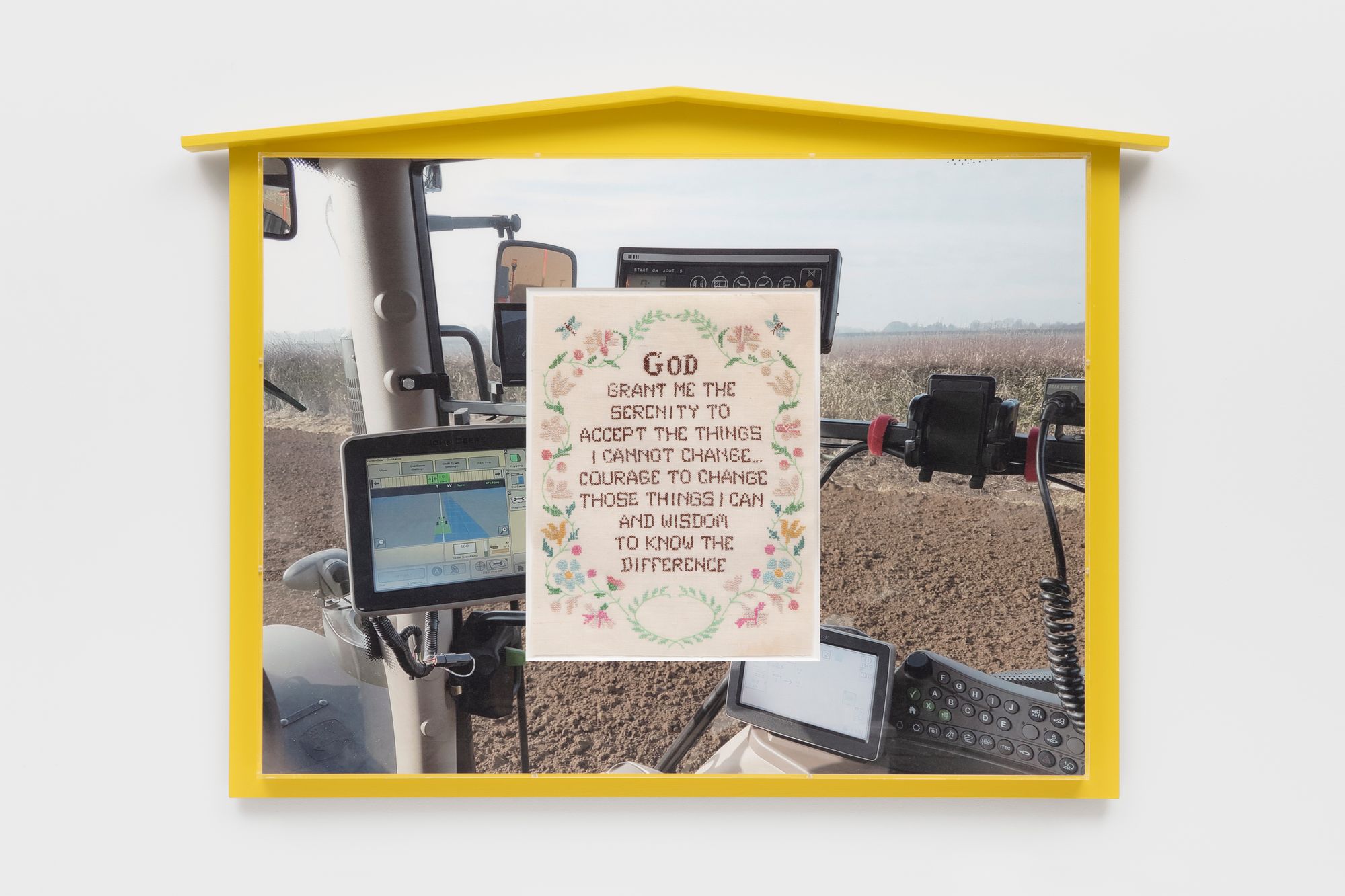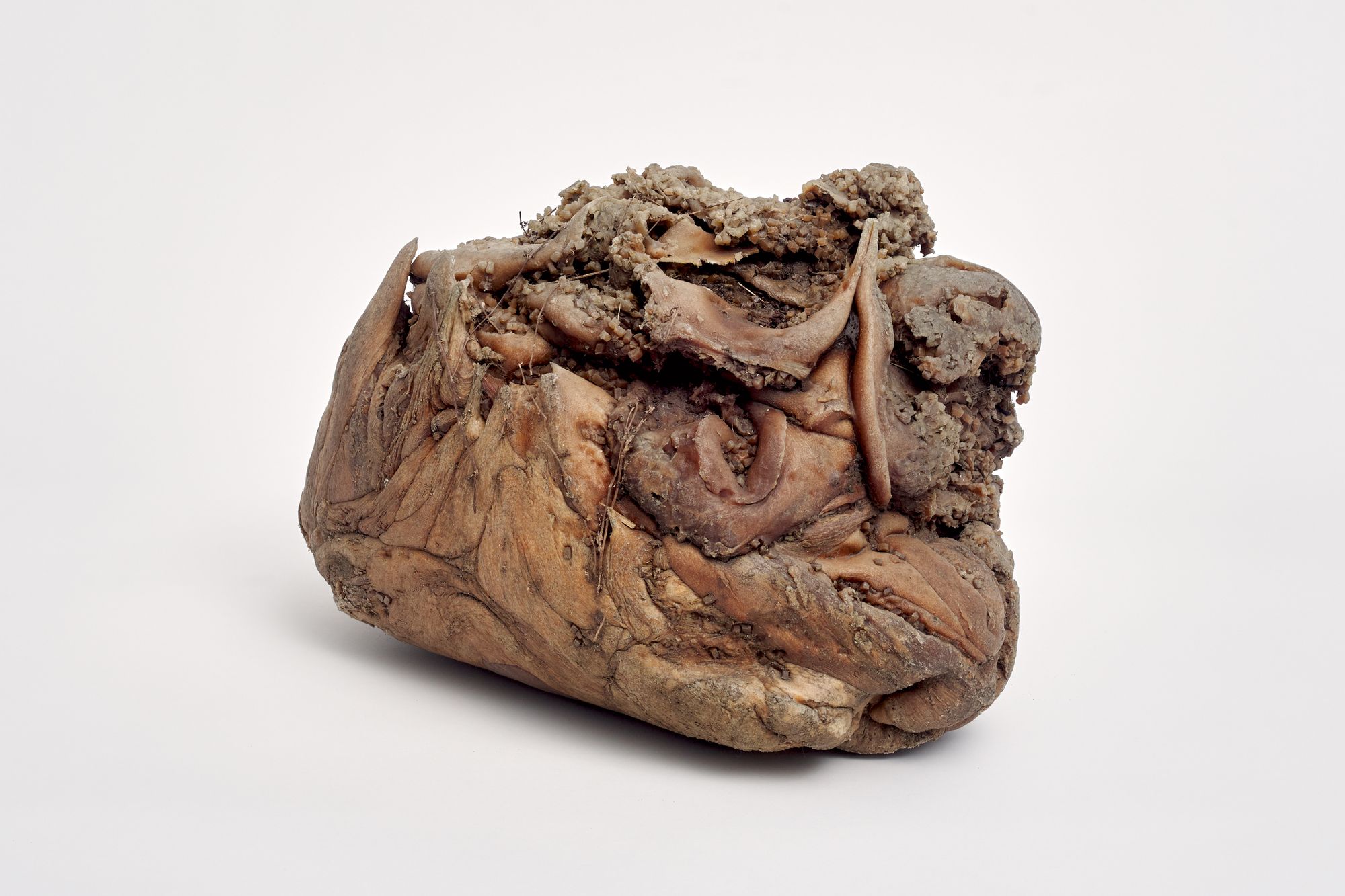
Past
Miles Huston
Cinderella Had a Farm
Sept. 7–Oct. 30, 2022
New York
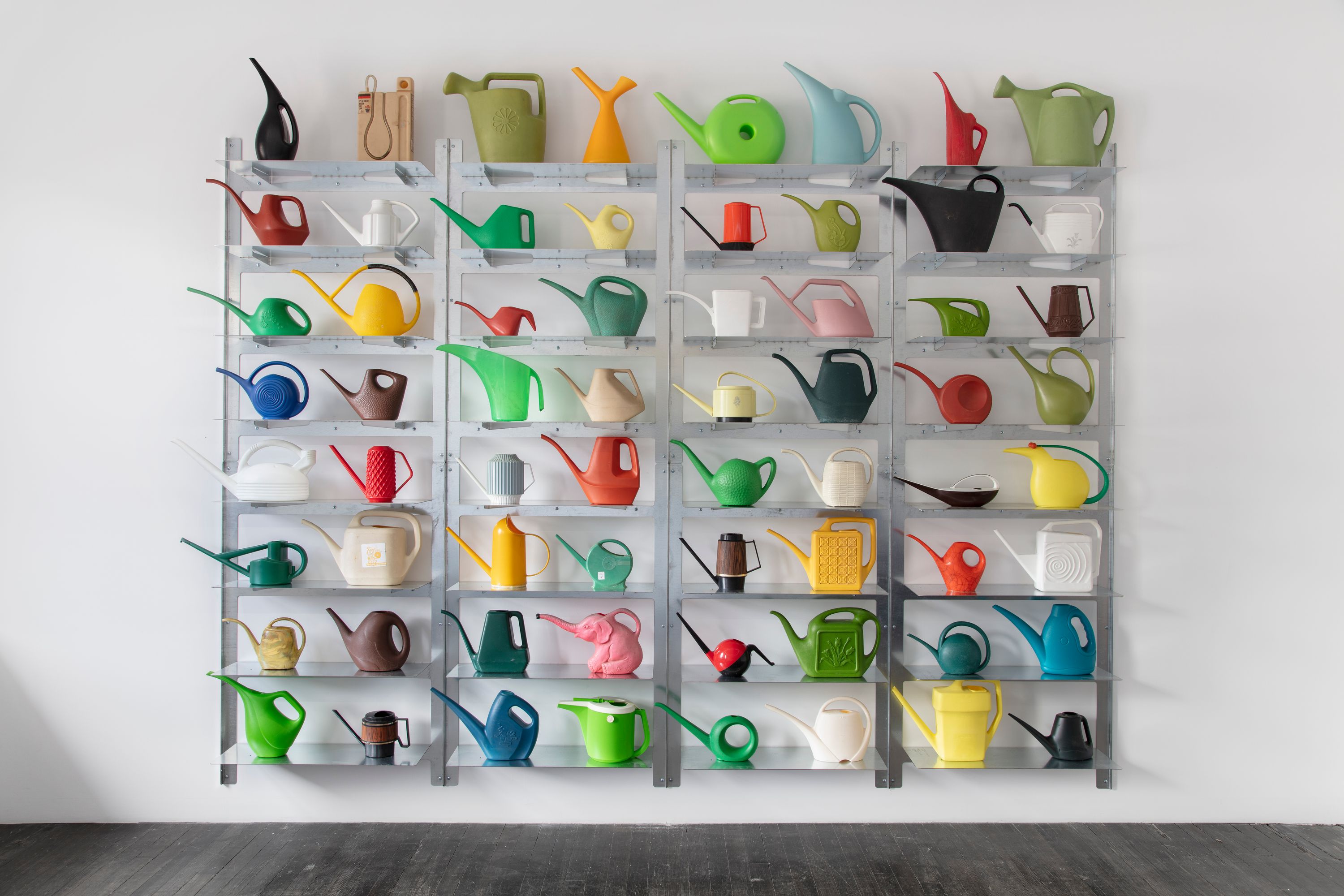
Gordon Robichaux is pleased to present Cinderella Had a Farm, Miles Huston’s first solo exhibition at the gallery following a two-person show with Jenni Crain in 2019. The exhibition is a continuation of Huston’s investigation of the competing narratives that shape our understanding of agricultural production and climate change.
Displayed in both of Gordon Robichaux’s gallery spaces (Suite 925 and Suite 907), Huston’s installation includes sculptures comprised of fabricated and found objects—plastic watering cans, welded metal display racks, an aluminum shelving system—and works that feature groupings of ephemera and printed images, presented within handmade artist’s frames shaped like houses with roofs. These house motifs are organized in clusters on the wall and suggest relationships between urban, suburban, and rural densities.
The artist’s collection of brightly colored plastic watering cans—Plantwater Collection (2014–ongoing)—appears throughout the exhibition in varied configurations. The mass-produced watering cans are arranged in three compositions based on Huston’s system of classification: Private (property), Government (asset), and Museum (collection). The largest of these features fifty-six of the plastic vessels, displayed on eight shelves designed by the artist to maximize efficiency and minimize waste: each unit is cut and bent from a single sheet of galvanized steel. Similarly, he adopts models of cooperative use for the other two sculptures: one features a system of coin-operated trolley locks used in cemeteries, while the other is based on stations in community gardens where individuals use their own locks to secure the cans.
A newly commissioned text by writer Paul Rusconi accompanies the exhibition.
Install (14)






Cinderella Had a Farm
Once upon a time, Cinderella married the King and quickly became beloved as the “People’s Queen.”
The King and his advisers decided to exploit Cinderella’s humble origins and benevolent nature by naming her head of Education or Housing, but Cinderella claimed Agriculture, because she knew the history of agriculture was the history of the world.
She embarked on a listening tour around the kingdom and was photographed inspecting fields, riding tractors, and milking cows. She presented each farmer with a needlepoint of the Serenity Prayer, which she encouraged the farmer’s wife to hang in a prominent place in their home.
She shared her findings during a cooking segment on the kingdom’s most popular morning show: “Farmers,” she said, wanted her to “streamline bureaucracy, increase efficiency, and centralize operations.”
What this meant was Cinderella alone would decide which crops, and how much of them, farmers could produce each year. She’d pay other farmers not to grow crops at all as a substitute for agricultural price support programs, though the press release only mentioned the policy’s “water-friendly conservation measures.”
She announced an initiative to grow the largest pumpkins in the world that could support nutrition programs and create clean energy. She launched satellites for crop surveillance and environmental monitoring, and limited groundwater pollution by consolidating all the cow farms into one sector of the kingdom. (That sector just happened to be upriver from her Stepmother’s chateau.)
Some farms prospered under Cinderella’s policies, but most failed because of drought, and with fewer working farmers, a food shortage developed. Citizen journalists studied the satellite data to figure out where all the water had gone.
They discovered the kingdom’s water was being diverted to support Cinderella’s Giant Pumpkin Program. (They also discovered Cinderella was tracking the movements of all the maids and fairy godmothers in the kingdom with VR scarecrows.)
The people were outraged. Starving rioters broke into the Giant Pumpkin facilities only to learn her pumpkins weren’t fit for human consumption.
The scandal became known as “Watergate,” and Cinderella acted quickly to quell it. She paid the medical bills for people who’d been poisoned by the pumpkins. She made museums free to the public and gave artists grants. Her Fairy Godmother created stimulus checks, Bibbidi-Bobbidi-Boo!
But the King and his advisers did not come to her aid. They allowed “Watergate” to fester and grow because they viewed it as an opportunity to boost the economy, rally the populace, and secure the kingdom’s water access for generations to come. While the public focused on Cinderella, the King secretly prepared for war.
One evening, Cinderella received an unexpected visit from an old enemy.
“Don’t worry, I’m here to help you,” her Stepmother said.
She told Cinderella about the King’s secret plans and warned her: “They will blame you for everything—for going to war, for losing the war, for sacrificing their children to the war machine. The King doesn’t care about you, he cares about his legacy. And there are plenty of other maids in the kingdom.”
Cinderella knew her Stepmother was right.
She summoned the Fairy Godmothers to the Giant Pumpkin facilities at midnight and agreed to reduce the surveillance of their movements and the regulation of their activities in exchange for their help transforming the giant pumpkins not into high-speed RELLA Rail, as planned, but into tanks.
At first light, the Queen deployed the tanks in a surprise attack on the King and his advisers. She interrupted the morning news to announce the change in leadership and reveal what the King had been up to. “War is not the answer,” she said. She declared water restrictions on golf courses and put an end to the Giant Pumpkin Program. She called on Fairy Godmothers to help restore the rivers and make the crops grow. She vowed her reign would be guided by two principles: what is best for the kingdom and what is best for the Earth.
Her Stepmother watched the Queen’s speech from home. She was impressed with her adeptness at blaming the King for the crisis without acknowledging her role in it, and by her composure despite the dangerous days ahead.
She thought Cinderella’s best path for a long reign was to focus on the first principle while ignoring the second, because the Earth would be fine no matter what we did to it. The Earth would still be the Earth even when there were no people on it. It would simply enter a new phase, and continue evolving, and might even thrive in a post-human ever after.
—Paul Rusconi
Works
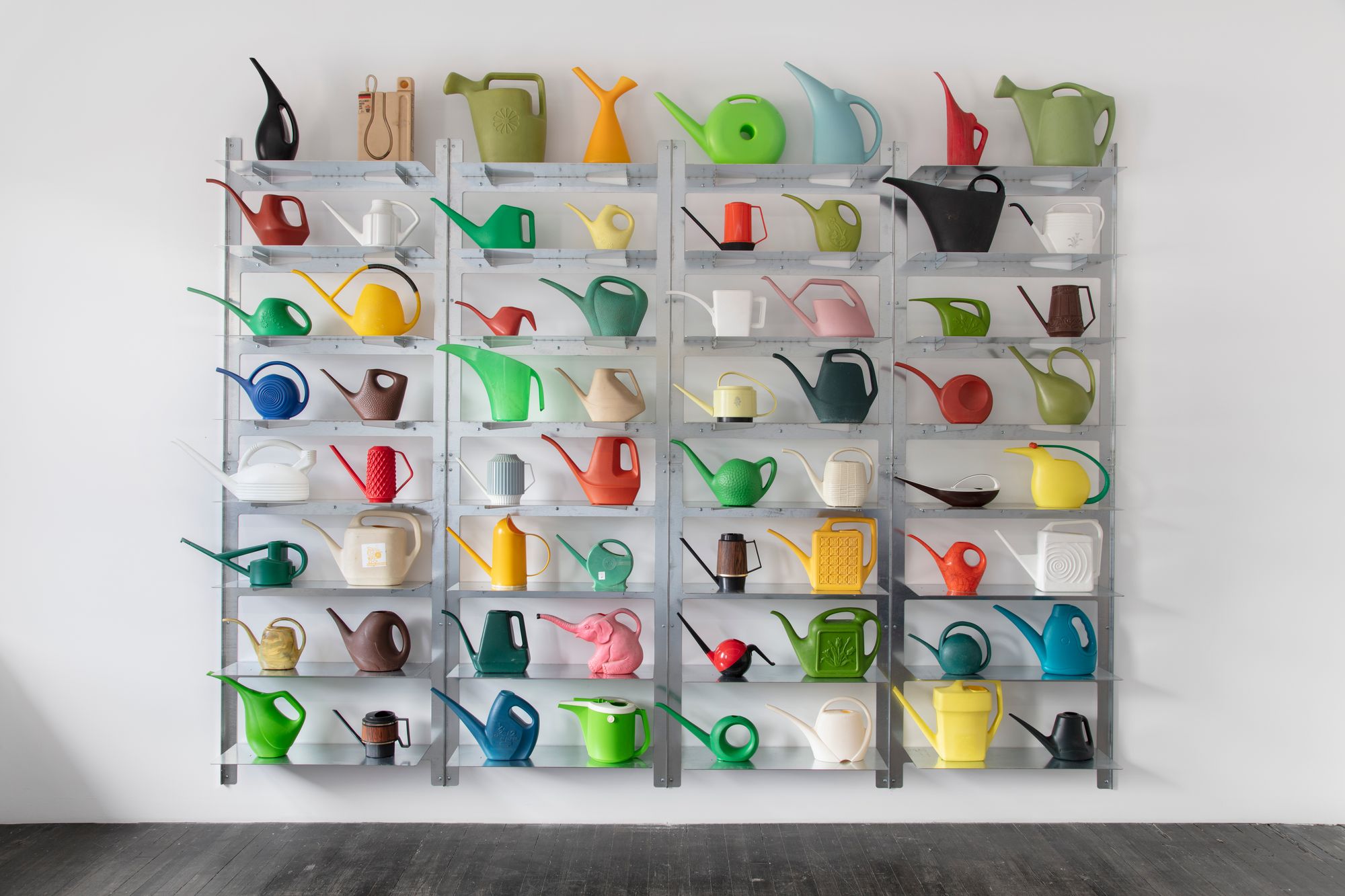
Plantwater Collection, Part 1: Museum (collection)
Plantwater Collection, Part 1: Museum (collection)
Watering cans, eight steel shelves designed by artist
Eight shelves: 43.5 x 30 x 9 inches each
2014–ongoing

Plantwater Collection, Part 2: Community Garden (property)
Plantwater Collection, Part 2: Community Garden (property)
Watering cans, locks, and steel
68 x 60 x 30 inches
2014–ongoing
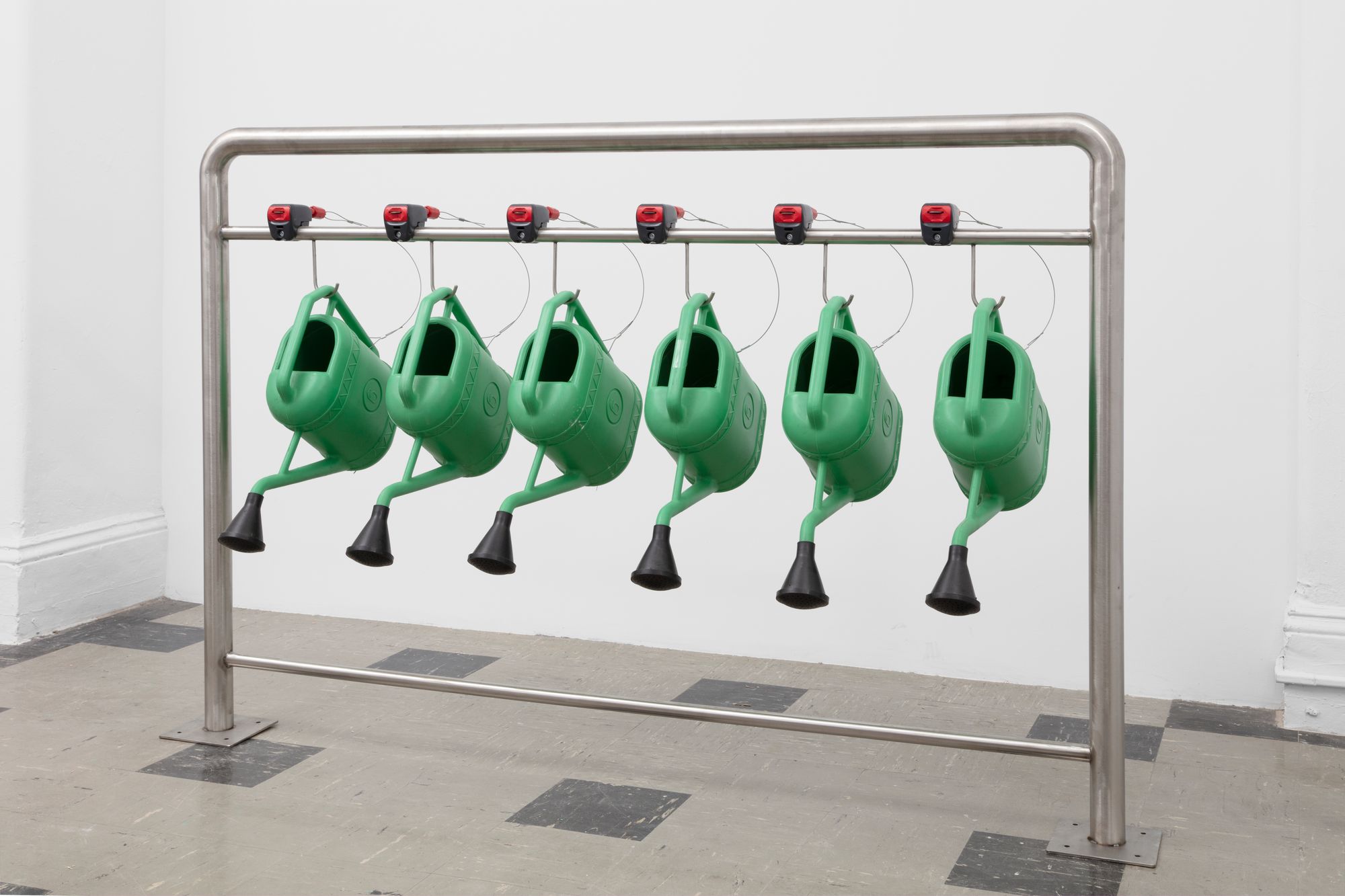
Plantwater Collection, Part 3: Community Garden (asset)
Plantwater Collection, Part 3: Community Garden (asset)
Watering cans, locks, and steel
44 x 64 x 20 inches
2014–ongoing
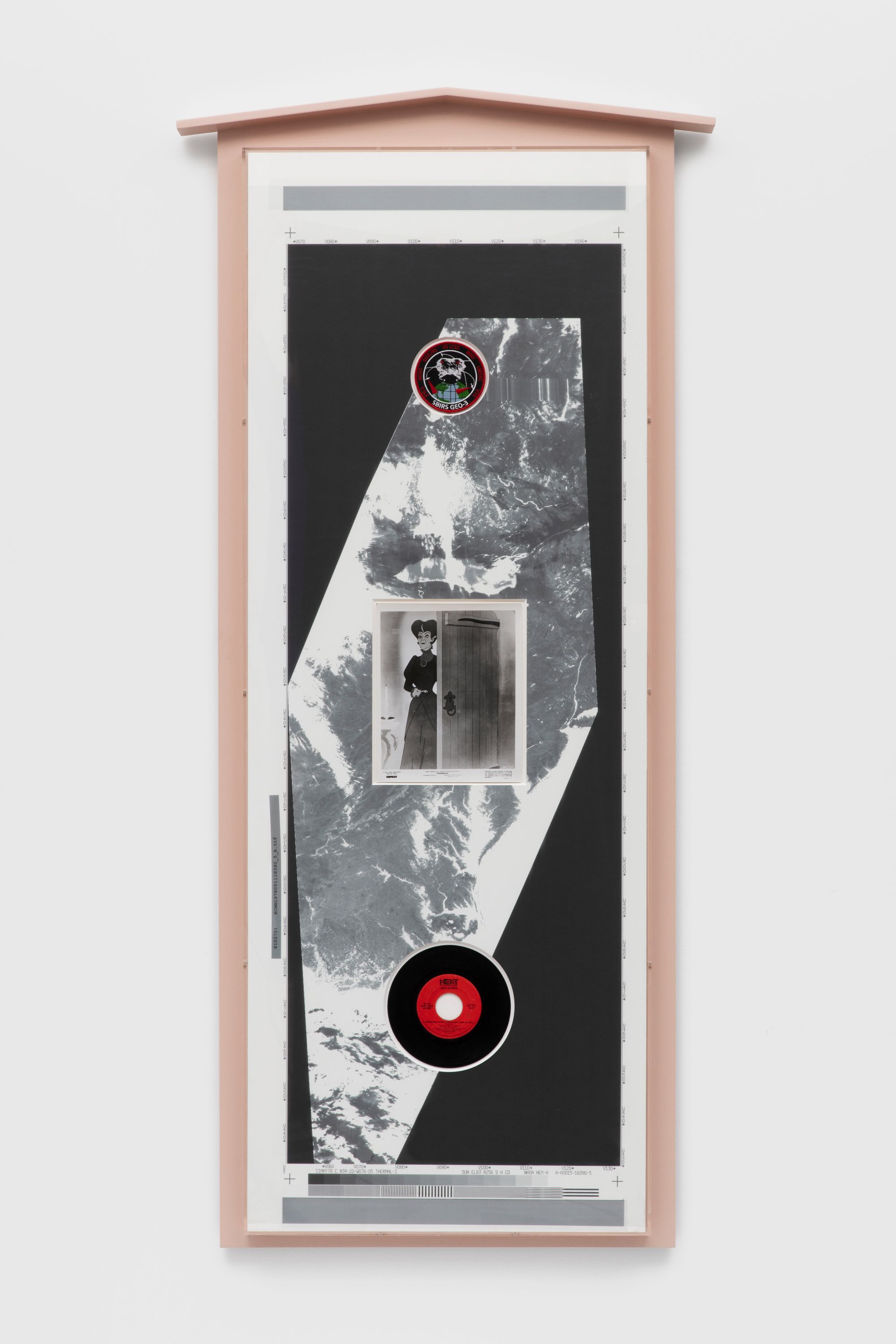
The Spinster
UV print on matte board, Evil Stepmother press photo, SBIRS GEO-3 mission patch, Salt-N-Pepa 7 inch, acrylic, latex paint, and wood
64.75 x 30 x 1.75 inches
2022
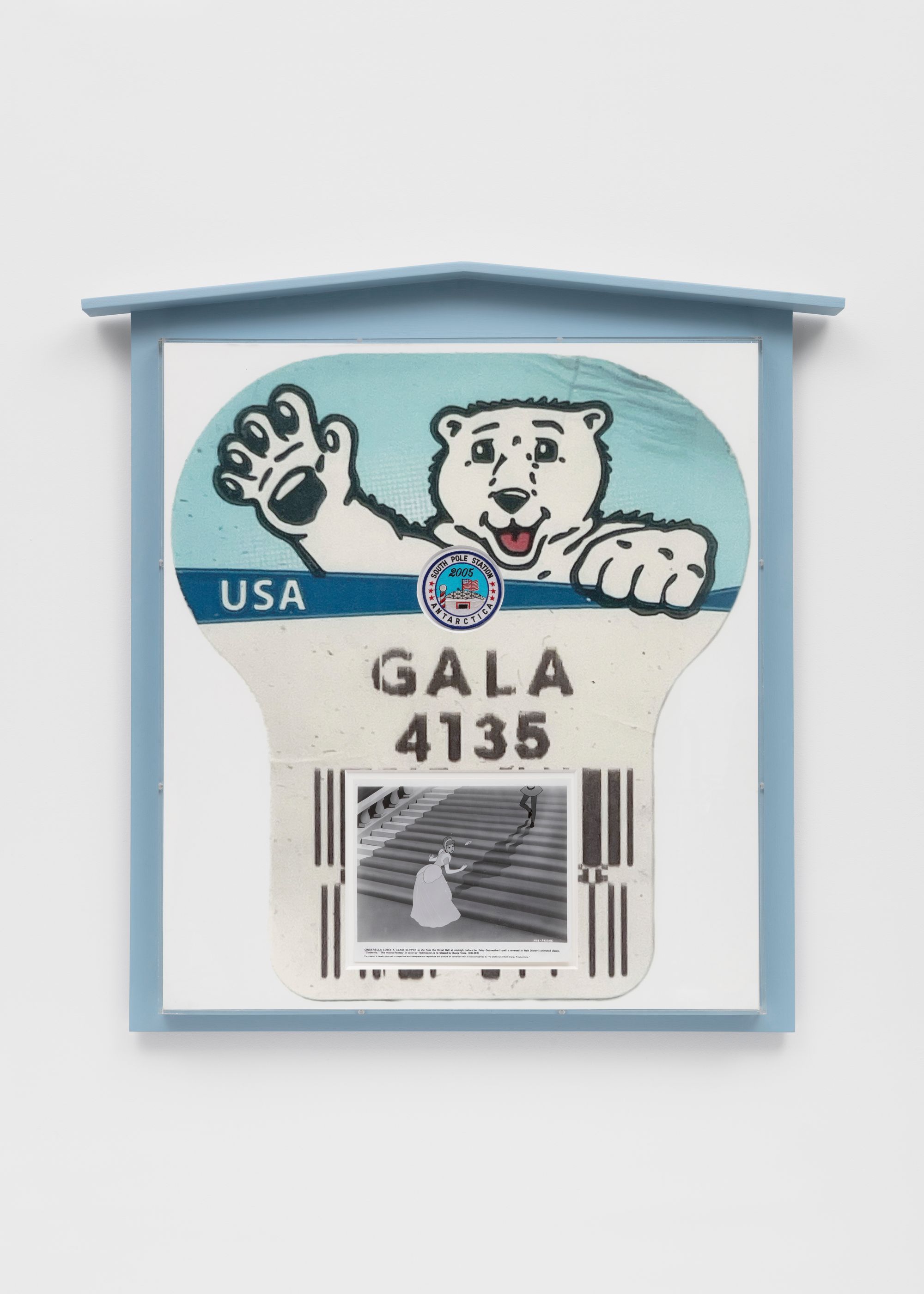
Seconds to Midnight
UV print on matte board, Cinderella press photo, 2005 South Pole mission patch, acrylic, latex paint, and wood
34.5 x 34 x 1.75 inches
2022

Feed the World
UV print on matte Board, Ronald Reagan press photo, Live Aid concert ticket, Live Aid trading card, acrylic, latex paint, and wood
28.5 x 46.5 x 1.75 inches
